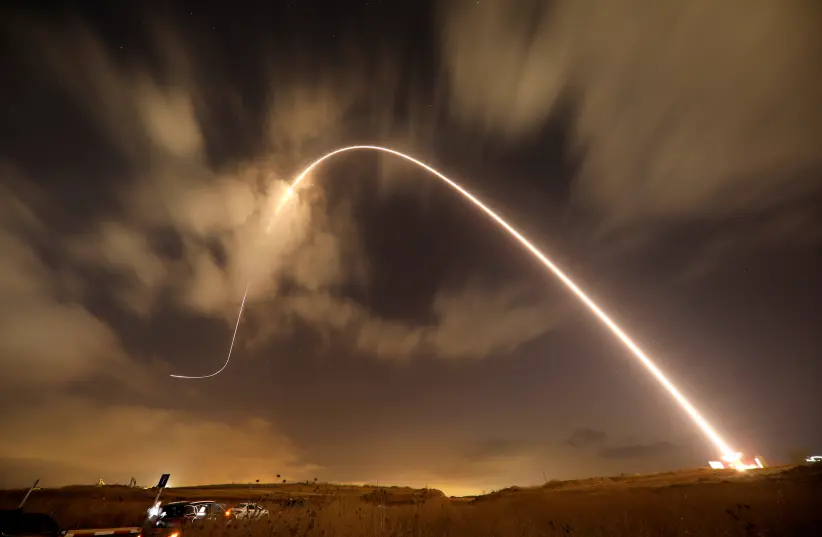Much remains unclear about the incident on April 22, including why Syria fired a missile so wildly and so far south into Israel – and whether Israel’s interceptors failed to stop the threat.
A sleepless night on Thursday morning left many in Israel wondering what sirens at two in the morning, sounds of explosions and stories of airstrikes in Syria reveal about a shadowy conflict in the region.
Israel used a Patriot air defense system to try to stop a Syrian surface-to-air missile that was fired from Syria and set off sirens near Dimona, where a sensitive nuclear facility is located.
Jerusalem has said the Syrian missile was not directed toward a specific target. However, that leaves questions about the explosions people reported from the South to the center, including areas near Modi’in and Jerusalem, and in Rehovot.
According to reports, the interceptor, apparently a Patriot system, failed to intercept the missile. This is not a good result when Israel said in the past year that it has increased the capabilities of its integrated, multi-layered air defense systems.
Israel has Iron Dome, David’s Sling and Arrow, three systems designed to stop threats from missiles and drones. It also has the US Patriot system. Jerusalem and Washington jointly developed Arrow and David’s Sling, and Israel built the Iron Dome, two batteries of which have been provided to the US Army in the past year.
Why was a Patriot chosen to take down the S-200 missile that was flying from Syria? Patriots were used by Israel in 2017 and 2018 against drones flying from Syria. The Jewish state has also had Patriot batteries in southern Israel for many years near Eilat. Patriot missiles have been used widely by Saudi Arabia against threats by the Houthis in Yemen, including ballistic missiles.
However, Israel’s drills last year were intended to use Iron Dome and David’s Sling against the same targets, to show they can operate well together. David’s Sling has ranges similar to those of the Patriot, and its interceptor is designed to fit into a Patriot battery.
Still, there are many unresolved questions about the April 22 incident. Why did Syria fire a missile in the direction of Dimona? If it is true that the missile did not purposely target this sensitive area, then why was it heading towards southern Israel in the first place?
Trying to see how a Syrian missile could even end up in southern Israel using a map indicates that the flight path would likely take it over parts of Jordan and the West Bank. Yet explosions were heard over Rehovot and Modi’in on the morning of April 22 during the incident that unfolded.
At around 1:40 a.m., Israel said that “sirens sounded in Abu Qrenat.” This is an area near Dimona. At 2:55 a.m., Israel said that “a short while ago, surface-to-air missile fire was identified from Syria, which landed in the Negev area. In response, a few minutes ago, the IDF struck the battery from which the missile was launched and additional Syrian surface-to-air batteries in the area.”
This leaves questions about what caused the Syrians to fire an air-defense missile. In March 2017, the Syrians also fired an S-200 that went over Jordan and had to be intercepted by an Israeli Arrow missile. It was carrying a large warhead of several hundred kilograms, and Israel judged it to be a serious threat.
The Arrow is designed to stop large ballistic missiles and threats that may occur beyond the atmosphere, like long-range ballistic missiles. Iran, for instance, builds missiles with ranges of several thousand kilometers and has supplied other missiles to proxy groups in the region. In August 2018, Iran sent long-range missiles to pro-Iranian groups in Iraq.
Reuters noted that “the Zelzal, Fateh-110 and Zolfaqar missiles in question have ranges from about 200 km. to 700 km., putting Saudi Arabia’s capital Riyadh or the Israeli city of Tel Aviv within striking distance if the weapons were deployed in southern or western Iraq.”
THERE WERE no reports in Syria of air defense being activated before the reports of the sirens in southern Israel; there were no reports of airstrikes either. Missile debris from the alleged S-200 missile Syria used was found in Israel.
People in Abu Qrenat apparently heard a loud explosion. Was that from the impact of the Syrian missile or from an interception? This is not clear. The S-200 debris was reportedly found some 30 km. from the Dimona facility.
Aurora Intel, an online Twitter account that uses open-source intelligence to track incidents, has focused on the Dumayr S-200 battery site as the alleged source of the Syrian fire. Aurora concluded that the Syrians may have preemptively fired a missile suspecting an upcoming Israel airstrike. Aurora also writes that the debris from the S-200 was found in a pool in Ashalim in southern Israel.
If it is true that Syrian air defense didn’t mean to fire a missile towards Dimona but were firing wildly as they have in the past, such as in March 2017, it still leaves questions about how such a large warhead was able to penetrate so deeply into Israel, which has some of the most well-defended airspace in the world.
The S-200 is not a sophisticated weapon. If it can cause such an emergency by being lobbed in the wrong direction, that leaves questions about more sophisticated weapons purposely targeting Israel.
In September 2019, Iran used drones and cruise missiles to strike at Saudi Arabia’s Abqaiq facility. Tehran has supplied the Houthis in Yemen with drones and ballistic missiles. It has sent precision-guided munitions to Hezbollah. It has trafficked ballistic missiles to Iraq and sent rockets and other weapons to Syria, as well as drones.
Much remains unclear about the incident on April 22, including why Syria fired a missile so wildly and so far south into Israel – and whether Israel’s interceptors failed to stop the threat.
 Eurasia Press & News
Eurasia Press & News




